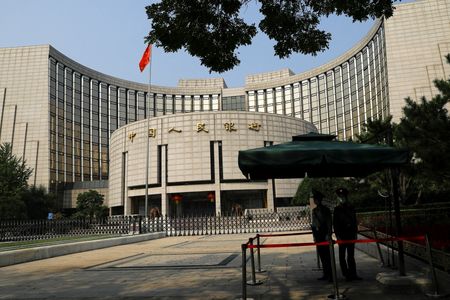By Kevin Yao and Ellen Zhang
BEIJING (Reuters) -China’s central bank announced a deep cut to bank reserves on Wednesday, in a move that will inject about $140 billion of cash into the banking system and send a strong signal of support for a fragile economy and plunging stock markets.
The central bank’s announcement, coming just as stock markets were closing for the day, led to a bounce in benchmark stock indexes and the yuan, even as analysts said more policy measures were needed.
The People’s Bank of China (PBOC) said it was making a 50-basis points (bps) cut, the biggest in two years, in the amount of cash banks must hold as reserves, effective from Feb. 5.
More importantly, PBOC Governor Pan Gongsheng said the bank would release policies on improving commercial property loans either on Wednesday or Thursday night, giving hope to investors who have been frustrated by China’s efforts to put a floor under a real estate sector that underpins consumption and household wealth.
The first cut in banks’ reserve requirement ratio (RRR) this year comes as the world’s second-largest economy struggles to mount a strong post-COVID recovery amid a housing crisis, local government debt risks and weakening global demand.
It also comes just days after China’s benchmark indexes hit 5-year lows as even the last hopeful investors waiting for clarity and an eventual economic rebound appeared to be giving up on the $9 trillion market.
“It’s a welcome step, but it’s not going to be a game-changer,” said Chris Scicluna, head of economic research at Daiwa Capital Markets in London.
“There are still questions about the extent to which the ‘National Team’, and various institutions can try to pull together to try to support the market and start up the buying of stocks and draw a line under the sell-off there.”
Stock markets in Hong Kong and China had stabilised slightly on Tuesday on reports of a cabinet meeting chaired by Premier Li Qiang to stabilise markets and of state-owned investment vehicles, known as the “national team”, being pressed into action, as they were during the 2015 crash.
GOOD START
At Wednesday’s surprise press conference in Beijing, Pan said the RRR cut would free up 1 trillion yuan ($139.45 billion) in cash for the economy, exceeding most analysts’ expectations.
“The RRR cut is a sign that PBOC will stick to a loose monetary stance throughout this year, despite having missed market expectation of an medium-term lending facility (MLF) rate cut earlier,” said Xu Tianchen, senior economist at the Economist Intelligence Unit.
“It’s also a sign that policymakers across the government want to ensure a good start for the economy by frontloading policy support. This is needed to achieve their ambitious growth target in a challenging year.”
The cut in reserves follows earlier cuts of 25 bps for all banks in March and September last year. The PBOC would also cut re-lending and re-discount interest rates by 25 bps for the rural sector and small firms from Jan. 25, Pan said.
“At present, China’s monetary policy still has enough room,” Pan said. “We will strengthen counter-cyclical and cross-cyclical adjustments, and create a good monetary and financial environment for economic operations.”
MARKETS UP, BUT CIRCUMSPECT
Hong Kong’s Hang Seng Index extended gains after the RRR cut was announced, ending the session up 3.6% to clock its biggest one-day gain in two months.
China’s stock market tumbled 13% in 2023 and had extended its slide in the new year amid relentless foreign selling. The blue chip CSI300 Index has risen 3.5% from five-year lows struck last week, but is still down more than 6% this year. China’s onshore yuan hit 7.1601, the strongest level since Jan. 12, after the announcement.
Earlier in the day, Reuters reported China’s securities regulators had asked some hedge fund managers to restrict short selling in its stock index futures market.
Since China has traditionally injected cash into the economy just before the Lunar New Year holiday week – which this time falls in early February – some analysts were circumspect about policymakers intent to defend markets.
“We like to wait to see a full set of policy supports before concluding the impact on overall market,” said Kiyong Seong, lead Asia macro strategist at Societe Generale.
MORE STIMULUS NEEDED
Analysts say more stimulus is needed this year as the government aims to spur growth to fend off deflationary risks and keep a lid on unemployment as businesses remained wary of adding workers.
In December, top Chinese leaders at a key meeting to chart the economic course for 2024 pledged to take more steps to support the recovery.
Zhiwei Zhang, chief economist at Pinpoint Asset Management, said China’s fiscal policy should focus more on boosting consumption, which would help ease deflationary pressures.
“China needs stronger domestic demand instead of more production capacity,” he said.
So far, a slew of policy measures and steps to support the stock market have proven only modestly beneficial, raising pressure on authorities to roll out more stimulus.
But the central bank faces a dilemma as more credit is flowing to manufacturing than into consumption, which could add to deflationary pressures and reduce the effectiveness of its monetary policy tools, analysts say. Pressure on the yuan continued to limit the scope of monetary easing as well.
The economy grew 5.2% in 2023, meeting the official target, but the recovery has been shakier than investors had expected.
Analysts polled by Reuters expect economic growth to slow to 4.6% this year.
($1 = 7.1712 Chinese yuan renminbi)
(Reporting by Kevin Yao, Ellen Zhang, Liangping Gao, Winni Zhou and Samuel Shen; Graphics by Pasit Kongkunakornkul;Editing by Vidya Ranganathan and Alex Richardson)

